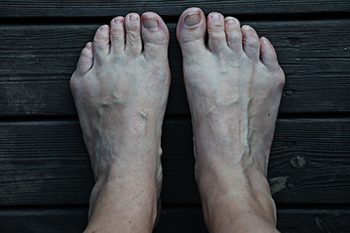
A tailor's bunion, also known as a bunionette, is a bony bump that forms on the outside of the foot near the base of the little toe. Unlike a regular bunion, which occurs on the inner side of the big toe, a tailor's bunion develops from pressure and misalignment of the little toe. The condition often results from wearing tight, narrow shoes or high heels that squeeze the toes, leading to the protrusion. Tailor's bunions can cause discomfort, pain, and difficulty finding well-fitting footwear. The pain may be aggravated by friction or pressure from shoes. Treatment for a tailor's bunion involves wearing wider, more comfortable shoes, using padding to reduce pressure, and potentially wearing orthotics to correct foot alignment. In severe cases, surgery may be necessary to realign the toe and remove the bony bump. If you have a painful tailor’s bunion, it is suggested that you schedule an appointment with a podiatrist for a proper diagnosis and relief options.
If you are suffering from bunions, contact Ankita Patel, DPM of All Pro Foot and Ankle. Our doctor can provide the care you need to keep you pain-free and on your feet.
What Is a Bunion?
A bunion is formed of swollen tissue or an enlargement of boney growth, usually located at the base joint of the toe that connects to the foot. The swelling occurs due to the bones in the big toe shifting inward, which impacts the other toes of the foot. This causes the area around the base of the big toe to become inflamed and painful.
Why Do Bunions Form?
Genetics – Susceptibility to bunions are often hereditary
Stress on the feet – Poorly fitted and uncomfortable footwear that places stress on feet, such as heels, can worsen existing bunions
How Are Bunions Diagnosed?
Doctors often perform two tests – blood tests and x-rays – when trying to diagnose bunions, especially in the early stages of development. Blood tests help determine if the foot pain is being caused by something else, such as arthritis, while x-rays provide a clear picture of your bone structure to your doctor.
How Are Bunions Treated?
- Refrain from wearing heels or similar shoes that cause discomfort
- Select wider shoes that can provide more comfort and reduce pain
- Anti-inflammatory and pain management drugs
- Orthotics or foot inserts
- Surgery
If you have any questions, please feel free to contact our office located in Swedesboro, NJ . We offer the newest diagnostic and treatment technologies for all your foot care needs.
